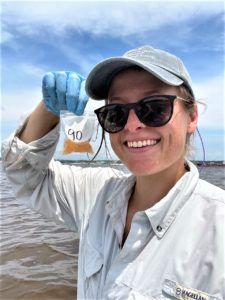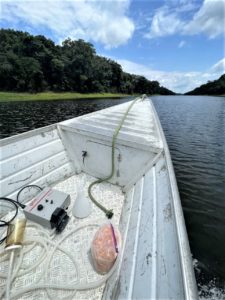Texas A&M student surveys endangered manatees in the Amazon
Kaitlyn Romoser ‘19 uses eDNA to locate elusive river manatee, aid conservation efforts for species
A student research project in the Texas A&M College of Agriculture and Life Sciences may help scientists protect endangered manatees in the Amazon River.

Inspired by her longtime interest in aquatic mammals and ecology, Kaitlyn Romoser recently spent a month in Brazil working towards her thesis. She collected environmental DNA, eDNA, samples to detect the presence of endangered Amazonian manatees.
Romoser, a graduate student in the Department of Ecology and Conservation Biology, is pursuing her master’s degree in ecology and conservation biology. She received her undergraduate degree in environmental studies and oceanography in 2019 from the Texas A&M College of Arts and Sciences.
Unfortunately, the pandemic interrupted her plans to attend a university with graduate-level oceanographic programs. However, she quickly remembered Texas A&M professors Kirk and Leslie Kelso-Winemiller, who led her and 19 other students on a study abroad trip to the Amazon while she was an undergraduate student. Leslie Kelso-Winemiller, Ph.D., is an instructional associate professor in the department.
She reached out to Kirk Winemiller, Ph.D., interim head of the Department of Ecology and Conservation Biology, about taking her on as a graduate student. After exploring several options for research on aquatic mammals, they settled on a plan to study Amazonian manatees using eDNA technology for her master’s thesis.
During her year-long preparation for the trip, Romoser corresponded with several Brazilian researchers studying manatees and found three scientists eager to collaborate.
“It was the perfect set of collaborators to work with and share data and findings,” she said. “The eDNA method has incredible potential for surveying animals, especially in areas as expansive as the Amazon.”
Amazonian manatees and eDNA technology
Amazonian manatees are the lone species exclusive to freshwater and the smallest member of the Sirenia order. Although they have few predators, they were hunted heavily for their meat, fat and leather.
To better protect the species, the Brazilian government began prohibiting hunting by 1973. Currently, their population continues to be negatively impacted by illegal hunting, ongoing habitat destruction, increasing pollution and boat traffic.
Wildlife management requires reliable population survey data. However, current methods for tracking Amazonian manatee numbers, such as visual sightings and side-scan sonar, are inefficient and result in significant data gaps.

Essentially, researchers using eDNA methodology test water for viable DNA strands that can be multiplied in the lab via polymerase chain reaction, PCR. This technology, which has improved dramatically in recent years, uses eDNA from a variety of sources, including saliva, excrement, skin or other material shed by the animal into the environment.
Applying that methodology to her study, Romoser visited the Amazon River during the dry season when she expected the reduced amount of water to concentrate manatees for the survey.
Samples were collected at three locations, including the Mamirauá Sustainable Development Reserve near the town of Tefé on the western Amazon, where manatees are more protected from human encroachment. The other survey locations were near the major cities of Manaus in the central Amazon and Belém in the eastern Amazon.
“Amazonian manatees are extremely elusive, so they are very difficult to survey by sight or even with sonar because they shy away from humans,” she said. “This survey will contribute data that Brazilian researchers and conservationists can use to protect this species.”
Passion for ecology and conservation teaching, collaboration, learning
Romoser said the manatee survey was an incredible experience. The project taught her about the planning and execution of international field research as well as how knowledge gained from coursework is applicable in the field.
As of now, not all results have returned from the lab, but she already is contemplating a return trip to the Amazon to expand the research for a possible doctorate degree.
Romoser is passionate about teaching ecology and excited about the prospect of hands-on fieldwork in the water. Her research experience, together with her role as a teaching assistant in the department, have convinced her she wants to become a professor.
“The study was good for me personally, because it took me out of my comfort zone,” she said. “It was a year of planning that came to fruition during one intense month. It was exciting to collaborate with other scientists and see the potential for eDNA in surveys of aquatic and land animals, especially over very large ranges. I think it has reinforced what I’ve done over my student career and what I want to achieve in my professional career.”


